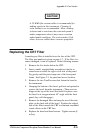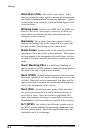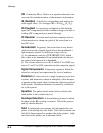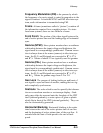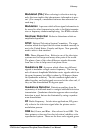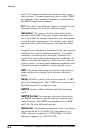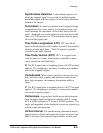
Glossary
1760 Series Component Waveform/Vector Monitor User Manual
G-3
B--Y (PAL) One of the color difference signals used in the
PAL system, obtained by subtracting luminance (Y) from the
blue camera signal (B).
CAV Component Analog Video; component video signals in
which an analog voltage or current (rather than a set of num-
bers) represents the value of the pixel; the same as “analog
components.”
Chrominance Chrominance refers to the color informa-
tion in a television picture. Chrominance can be further bro-
ken down into two properties of color: hue and saturation.
Chrominance Signal The high-frequency portion of the
video signal which is obtained by quadrature amplit ude m od-
ulation of a 3.58 MHz (NTSC) or 4.43 MHz (PAL) subca rrier
with R --Y and B--Y information.
Color Black See Black Burst.
Color Correction A process in which the coloring in a
television image is altered or corrected by electronic means.
Care must be taken to insure that the modified video does not
exceed the limits of subsequent processing or transmission
systems.
Color Difference Signals Signals used by color televi-
sion systems to convey color information in such a way that
the signals go to zero when there is no color in the picture.
R--Y, B --Y, I, and Q are all color difference signals for the
NTSC system; U and V are color difference signals for the
PAL system.
Component Video Video which exists in the form of
three separate signals, all of which are required in order to
completely specify the color picture. For example, R, G, and
B; or Y, R--Y, and B--Y.
Composite Video A single video signal containing all of
the necessary information to reproduce a color picture.
Created by adding quadrature amplitude modulated R--Y and
B--Y to the luminance signal for NTSC systems or U and V
to the luminance signal for PAL systems.



